“Vous-avez fait déjà 1001 km”. It was a beautiful afternoon when I rode past that humble sign. Locals stood by the roadside cheering us on, and I started to cry.
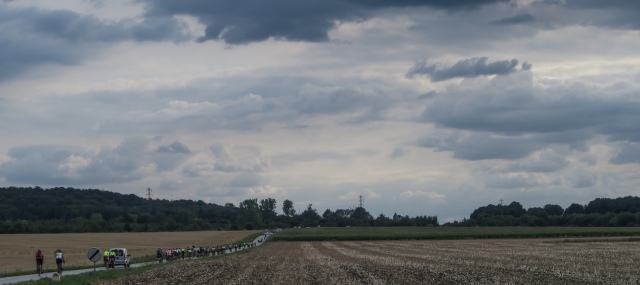
Having left Paris 69 hours earlier, I still had 230km ahead of me. But with more than five hours time on hand, I felt pretty confident that – barring disasters – I would make it.
I had expected a lot of suffering on PBP, the 1235 kilometer non-stop bike ride from Paris to Brest and back again: Saddle sours, hot feet, Shermer’s neck, falling asleep on the bike – the internet is full of long-distance rider’s horror stories.
But to my big surprise, I was feeling really strong despite having ridden 1001 km.
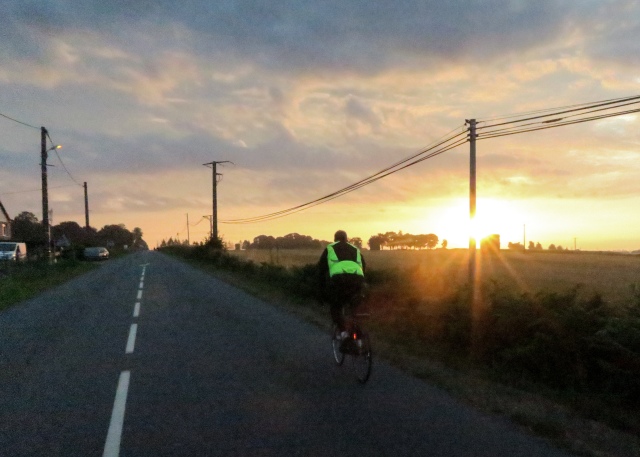
The second half of the ride was actually going better than the first one. I had found my rhythm, had met the perfect cycling companion, and being on my bike had turned into a spiritual experience. I felt like the bike and myself had become one entity. A magic experience I had never had before.
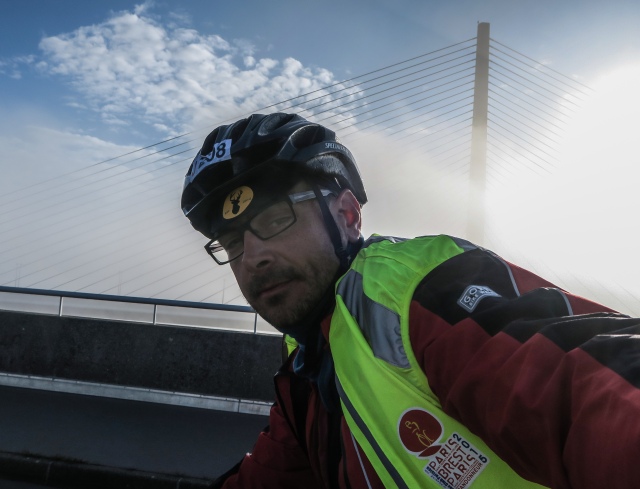
This is not to say Paris Brest Brest was a walk in the park. It wasn’t. I had experienced my low-point after about 350 km, about 20 hours or so into the ride.
I had ridden through the first night with a German chum called Jan, ate and drank loads and took great care to pace myself.
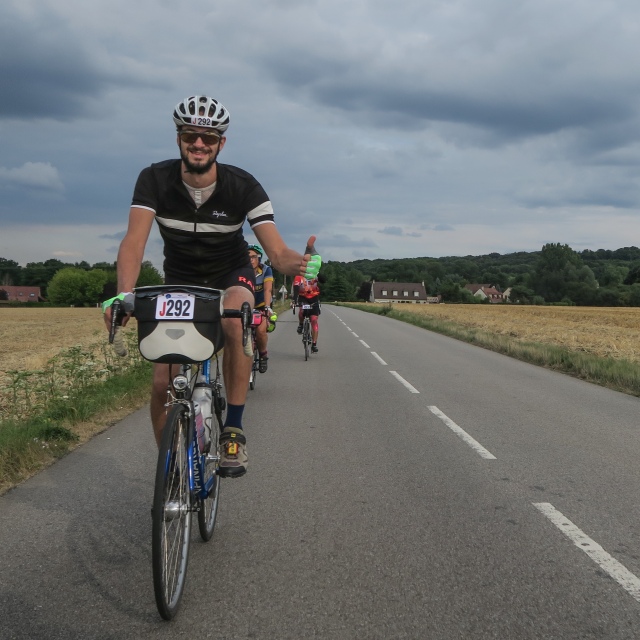
Nonetheless, the rolling hills between Villaines and Fougères, the first and second control, got the better of me. Jan was stronger at that stage and had gone ahead. I was riding on my own most of the time during the first day, tired and with legs on fire. The pain was alright as long as I was pedalling, but at Fougères and Tinténiac I could barely walk, as my legs ached and stiffened up.
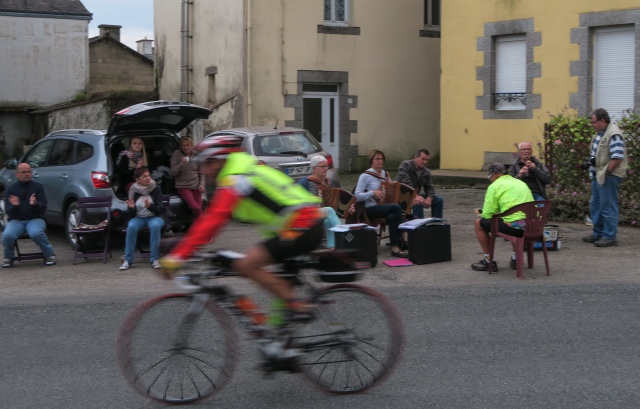
Well, I thought, if it goes downhill from here, I don’t see how I will make it to Brest not mentioning Paris. However, one of the magics of long-distance cycling is that while you will feel just awful at times, you usually will feel better if you carry on.
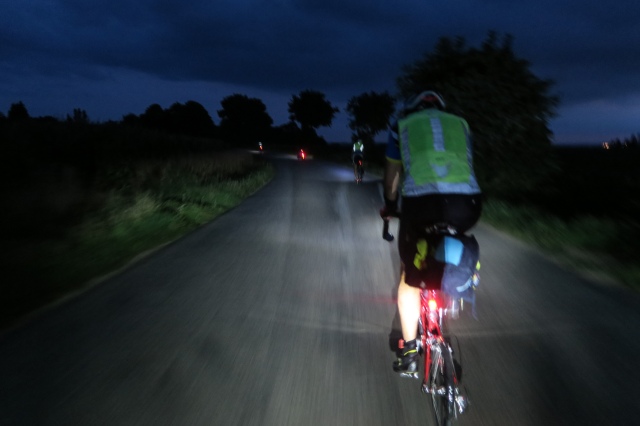
At Tinténiac I had a beer and – for the first time ever on a ride – used Ibuprophen which magically silenced my legs. I was spared the stomach issues some people experience, and after a second dose of Ibuprophen, the leg pain was gone for the rest of the ride.
Instead, my bike started to play up. I could not shift into the two or three highest gears anymore – potentially a sign that the gear cable was on the way out. Luckily, there are bike mechanics at PBP controls. At Louedac, after 448km, I got my bike sorted, using the time for a relaxed dinner and a shower.
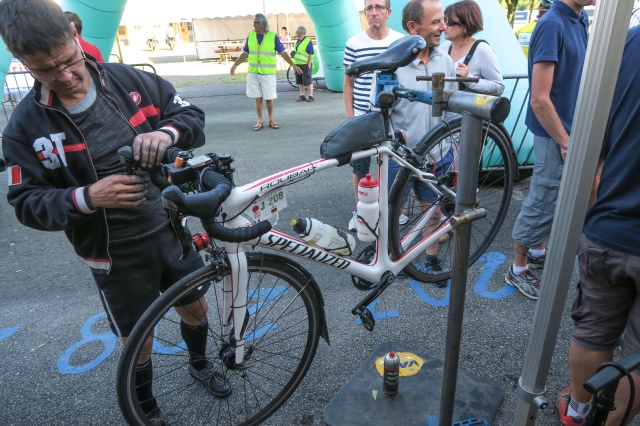
The mechanic’s bill was 27.50 euros. I handed over 30 euros adding “C’est bon, merci beaucoup!” The girl at the till replied: “Mais non, pas du tout!” and insisted on returning the exact change.
This example captures the PBP spirit. The volunteers and the people living along the route are absolutely enthusiastic and supportive in any possible way – from egging us on with a never-ending chorus of “Allez! Allez!” and “Bon courage” to handing out free water and coffee in the middle of nowhere at 3am in the morning.

During the first night, when I was running low on water, three girls were standing at a lonely roundabout. I stopped and asked them “Avez-vous d’eau?” “Mais bien-sur!” they replied and filled my bottle. They also insisted on giving me chocolate, and a big hug.
Here’s a video catching the atmosphere nicely:
Sleep
Getting the sleep right was one of my biggest concerns. On my 400 qualifier in April, lack of sleep almost brought me down. I tried so get some kip in a bus shelter at 3am, but it was way too cold to sleep. I carried on but at snail speed and with way too many stops. The final 70km took forever, and I had thoughts of throwing my bike into the ditch, and bailing out of PBP.

I bought some super-lightweight sleeping kit afterwards that shall enable sleep almost anywhere: a Therm-A-Rest NeoAir Xlite mattress, a Cascade Designs sleeping bag inner liner and a Terra Nova Ultra Bivi bag. At 1 kg in total, the extra weight is bearable. I used it once on PBP during the third night at Quedillac, when there were no free beds and many people crashed out on the floor.

For most riders, the standard PBP time limit of 90 hours means riding through four nights. There is little alternative to riding through the first one, as the ride starts in the early evening. Sleep in the first night means constantly bumping against the intermediate control closing times, a lot of mental stress early on and the risk of being disqualified.
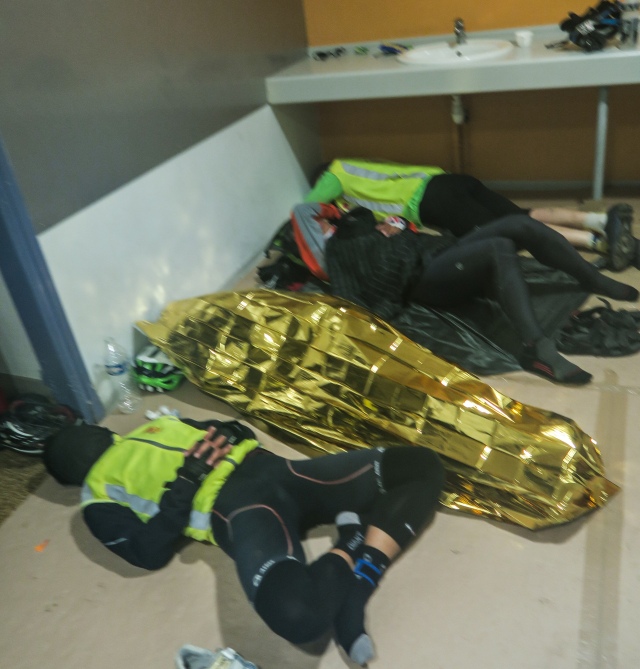
I got my fist sleep after 496 kilometres at Saint Nicolas du Pelem, where I arrived at 10pm on Monday, almost precisely 28 hours after I had left Paris. I slept in the dormitory for 2.5 or so hours and was back on the road at 2.45am.
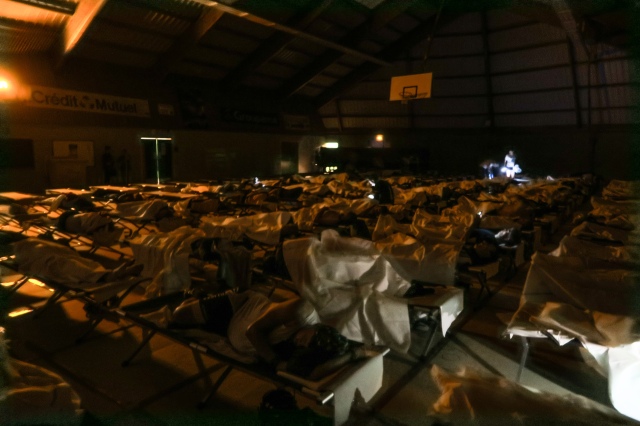
On Wednesday afternoon, I had 40 minutes of kip in the grass at Carhaix after 700 kilometres. In the third night, I rode until Quedillac (839 km), where I arrived at 1.20am. I slept for maybe three hours and was back on the road at 5.30am. In the fourth night, I slept two hours in the dormitory at Mortagne (1088km) and got back on the road shortly after midnight.
In total, I slept little more than eight hours, while being 87 hours on the road. This does sound terribly little sleep, but it was fine for me. I never felt dreary or sleepy on the bike, always woke up before the alarm clock, did not hallucinate and never felt the need to sleep in the ditch. I was carrying caffeine tablets as a contingency and took some on the first afternoon, and before heading off into the dark at Loudeac towards Quedillac.
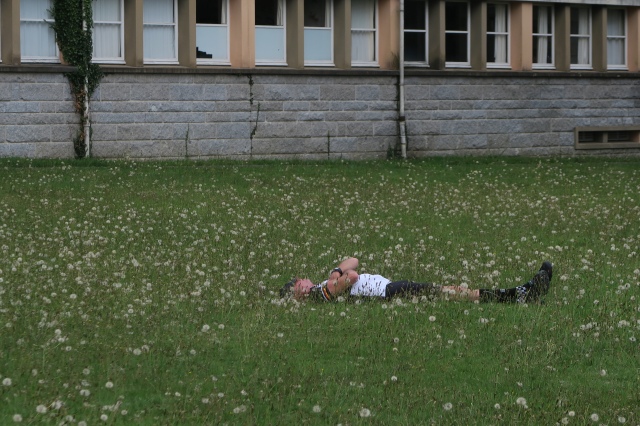
Many other PBP riders were obviously struggling with the lack of sleep. Even during the first night, some were taking a cat nap by the roadside. From the first afternoon, there was a trail of destruction of tired riders crashing out in the ditch by the road.

Getting used to night riding and little sleep is one of the key preparations for PBP, in my view. How? Well, just do as many night rides as you can before signing up for PBP. If you live in Britain, do the Friday Night Rides to the Coast.
Preparation
PBP was a long journey, but getting ready for it was an even longer one. Taking part in PBP had been a dream of mine since I had first heard of it more than a decade ago, but for many I had thought I could not do it. I had done cycling touring for years, and was riding about 4000 to 8000 kilometres a year. But I was relatively slow and overweight.
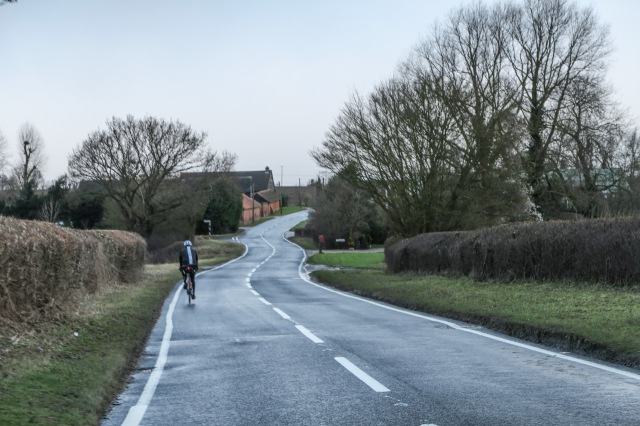
After moving to London in 2009, I had run into a cycling club called “The Fridays” which once a months does a thing called Friday Night Ride to the Coast – riding about 100 kilometres from central London to the seafront. I joined them as often as possible, and met new friends who lured me into longer rides and Audaxing.
In 2014, the year I turned 40, I decided to eventually address my overweight problem: Within the 18 months until PBP, I lost about 20 kg in body weight. The dream of doing PBP was a good incentive. At the same time, stepping up my time on the bike beforehand also helped in losing weight (as well as cutting down on alcohol and watching my calories intake closely).
In the summer of 2014, when I seriously started to toy with the idea of signing up for PBP 2015, I started my “Randonneur Round the Year” (RRtY) series: The challenge is riding at least one 200 kilometres Audax each calendar month. And in 2015, the PBP qualification rides came on top.The 600 kilometres qualifier had been my longest ride ever so far, and I did not find it too easy. My 400 kilometres qualifier was even harder – I almost literally crawled to arrivée.

I also started to do some make-shift interval training: riding 6 loops around Regent’s Park once or twice a week as fast as possible, while stopping at red lights. My average Audax speed increased markedly during spring and early summer, and I got better in minimizing the time off the bike.
Kit
I bought a lightweight carbon road bike for my PBP, a Specialized Roubaix.
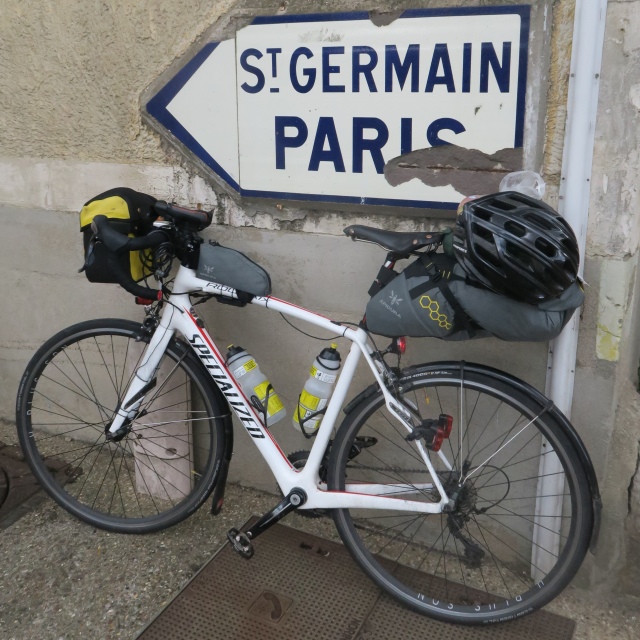
I tweaked the bike significantly for long-distance riding: fitted it with mudguards, a Brooks leather saddle and a SON hub dynamo. Probably the 150 pounds best spend on PBP preparation were the ones for the professional bike fit at Cadence Cycles near Crystal Palace in January. The changes to my bike’s setup were relatively minor, but did all the difference. I am now able to ride 87 hours in a row without any pain worth mentioning.
I use a lightweight Apidura Saddle bag to carry spare cloths and the sleeping kit, while most of the food goes into an Ortlieb bar bag. Tools and spare inner tubes are in an Apidura top tube bag, while my money, phone and the Brevet card are in a bum bag. (Here’s a detailled list of the stuff I took on PBP)
During the RRtY and the qualifiers, I constantly tweaked and improved my kit, and was very pleased with the setup on PBP. There is little I will change next time.
Tactics on PBP
In the months before PBP, I had spend hours after hours poring over spreadsheets working on a “strategy” for the ride: How much time to spend at the controls, where to sleep, and so on. Like most good strategies, it fell apart at the first contact with the enemy. Overall, I spent much more time at the controls than I had anticipated. But I was also riding faster than expected, and as I had five hours in hand most of the time, I did not really care about minimizing time at controls.
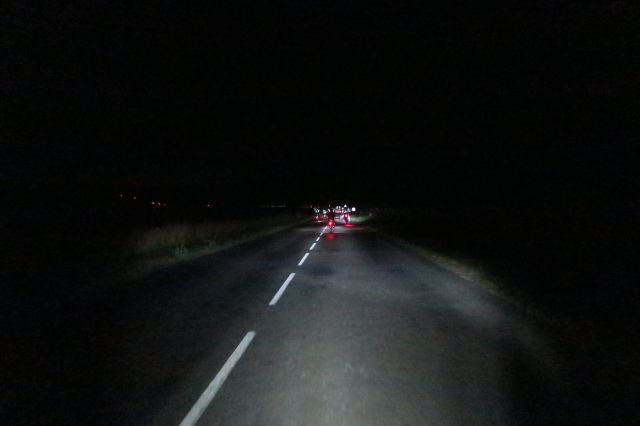
Moreover, I had run into the perfect ride companion – a British chap called Martyn on a Moulton- after about 500 kilometres and stuck with him for the next 500 kilometres. For hours after hours, we chatted away drafting each other, trying to keep the effort constant and changing positions every one or two minutes which is said to save about 20 percent of the energy. Several times, this developed into a “train” of riders. At one time, we had a chain of eight riders going.
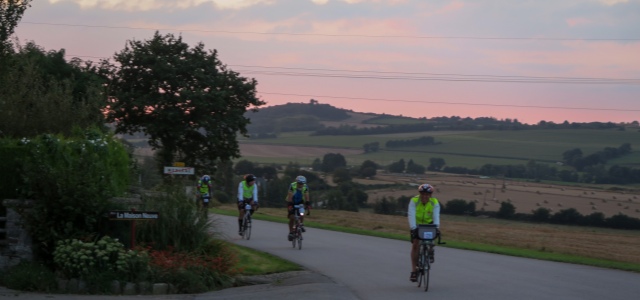
One part of the strategy that worked nicely was my plan for the first night. My cycling chum Frank, an experienced Audax rider and PBP veteran, had advised me to take as much food as possible on the first night to avoid the queues at the first controls and get ahead of the dreaded “bulge” of riders. I had made sandwiches from two baguettes, and had plenty of other stuff as well (enough to share some of it with Jan).
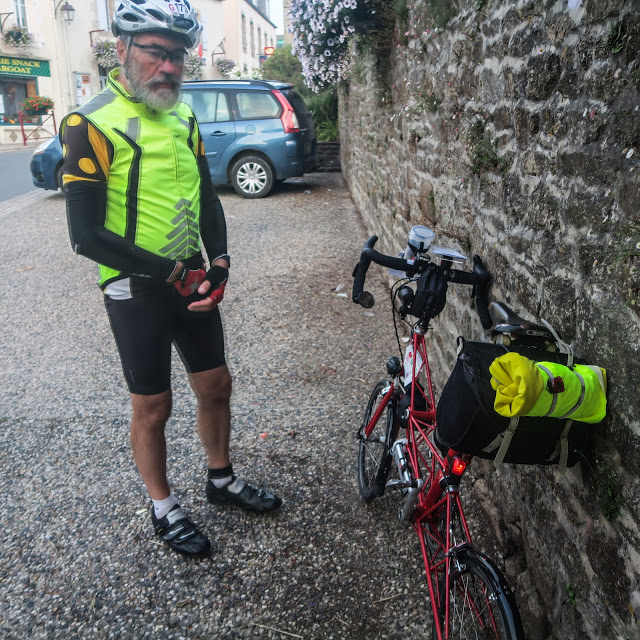
We bounced the first food stoop after 140 kilometres and apart from filling up water bottles and short pee stops, we did not get off the bike until the first real control in Villianes after 220 kilometres. By that, I had gotten in front of the bulge – large queues at the control, which were a problem for many riders, were never an issue for me.
The mind game
Endurance sports is as much a mental challenge as it is a physical one. One of the best pieces of advice I got at an early stage of my career as a long distance cyclist: While on the bike, don’t think about distances. Don’t bother how far you have ridden already, and how much is left. Just ride, and sooner or later, you’ll make it to the next control.
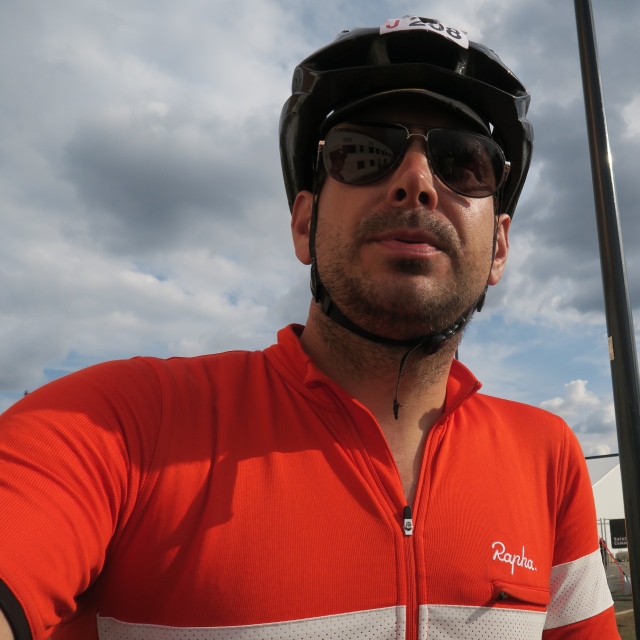
Adhering to this advice can be difficult, especially when you’re knackered but it’s really worth trying.
I find it also helpful to not think in distance but in time. My mental exchange rate, based on a speed of 20 kilometres an hour, is 3 minutes per kilometer. So if a sign says 9 kilometres to the next village, I think: “ok, that’s another half an hour or so.” It’s a mental trick that helps me a lot, as covering distance means physical effort but the time will pass anyway.
As a cycling friend pointed out to me after reading this, Macbeth expressed similar thoughts, albeit slightly more elegantly:
“Come what come may, Time and the hour runs through the roughest day.”

Dealing with lows during a ride is probably the most important success factor. Everyone, even the strongest rider, experiences his dark moments once in a while. The amazing thing is that it’s possible to overcome such moments by carrying on. No matter how bad you feel, it will get better if you keep pedalling.
Friends
One of the nicest aspects of Audaxing is the the sociable part. While riding with the Fridays and doing Audax UK brevets, I have made many new friends.
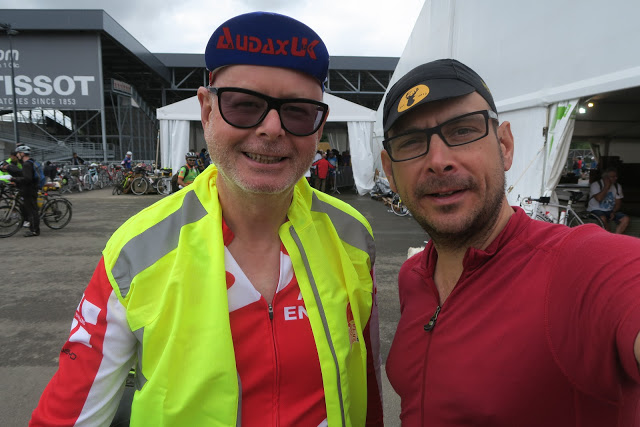
Running into some of them on PBP was always a highlight. The Friday’s very own “mmmmartin” Martin was the first familiar face, as we met at the bike check on Saturday.

Another good cycling mate was the Friday’s Tim. We had ridden the most parts of the 600 km qualifier together and were in the same starting group. We had intended to ride together through the first night. Unfortunately, we lost each other when Jan and I took a wrong turn, following a misplaced sign 50km after Paris. Oddly enough, we met again after 1000 km on the way back. Tim and I also happened to be on the same Eurostar on the way back to London after the ride. We both felt very smug at the time.

While on the road, I also met Frank, who taught me many things about Audaxing and had started in the 84 hour group, 12 hours later than I did I met several chums of Audax Club Hackney and rode with them, and I also made several new friends on the ride, first and foremost Jan and Martyn.
I also thought a lot of another London cycling chum Michael. We had done many Friday Night Rides and PBP qualifiers together. But as he was injured, Michael unfortunately could not do come to France.
Chatting up other riders is one of my key tips for Audaxing, especially when feeling bad or tired. Talking to somebody is the best way to distract yourself from your agony and stay awake. One of the weirder aspects of Audaxing is that you can have very personal conversations which people you have never met before for hours, but after the ride you may never see each other again.
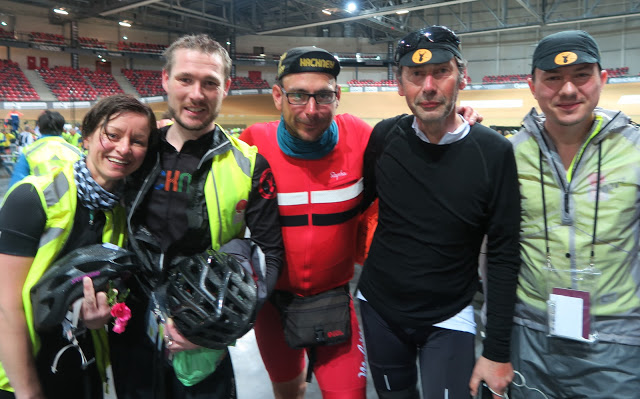
I’m more sceptical of trying to do PBP from start to finish with a particular partner. The controls are so big and busy that you can easily lose each other, and then you may waste valuable time looking for your cycling partner. Moreover, on a ride as long and challenging as PBP, you will invariably have weak moments, as will your partner have. If that happens, you may end up riding too fast and run yourself into the ground, or you will go slower than you could. Your sleep patterns may also be different. So if you are not willing to separate in such occasions, you are likely to slow down yourself mutually.
So my general attitude on Audaxing is: Be independent, but be sociable.
What would I do differently?
Actually, not too much. Losing more weight, getting fitter and hence faster is the core challenge. One relative minor thing is that last time I changed into non-cycling cloths before sleeping, which is a bit of a faff.
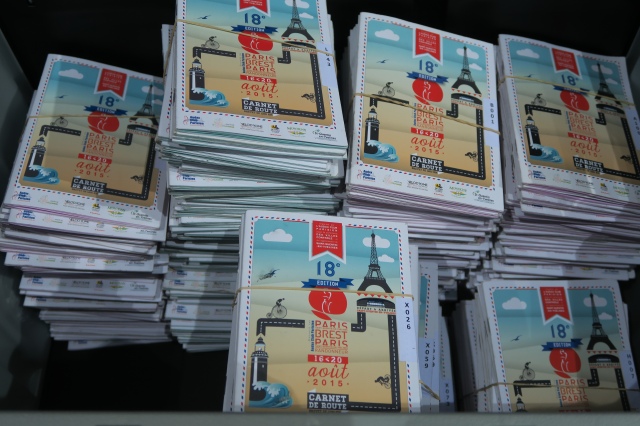
As long as I’m not soaking wet, I’ll just sleep in my cycling kit next time. I will also try to be a bit more efficient at controls, and stop at more roadside village parties. Changing all cables before the ride is another lesson.
Will I do it again?
You bet! Actually, I have decided to carry on with my RRtY, I want to ride London Edinburgh London in 2017 and have signed on for a very challenging 1000 kilometres ride in the Pennines in the summer of 2016. Audaxing can be a highly addictive drug.
P.S. As they say if it’s not on Strava, it did not happen, here’s the key link.


An excellent account of a ride which truly can be described as “epic” (a word casually used nowadays). My experience in this, my first PBP, was much the same, but with less sleep. Same detailed plan…gone wrong after the first night. Same unbelievable hospitality and support by French citizens young and old. Difference: I rode alone for nearly the entire 1230km. The hills and bumpy pavement after Loudeac (Westbound) were a harsh surprise. PBP has such lore, such a reputation, so much advance hype – and it lived up to it all, in difficulty and kindness and amazement. They say that PBP changes the person, and I agree.
“They say that PBP changes the person, and I agree.”
That’s really true.
Great write up thanks, and of course – Chapeau !
I plan to be starting in 2019 for my first P-B-P. see you there.
Your tale from the saddle is an inspiration to those of us with one eye on PBP 2019 and one eye on the bathroom scales. My weight at the start of October was 110kg (where it has been for more than ten years) but, after racking up a few miles on my fixed-wheel bike, my weight at the start of December should be around 107kg, and my stamina shows significant signs of improvement already.
In three and a half year’s time, I hope to be down to about 90kg, so I can face the first hill without fear. Well, maybe a little bit. At least my stomach won’t block my view of the route card. Fingers crossed.
Good effort! I came down from 105 to 85 kg from January 2014 to mid-2015 (currently back to 87-ish kg, as my discipline after PBP slipped, but I’m fighting back and try to get down to 80kg until the end of May 2016, as I’ve signed up for a 1000km Audax in the Pennines….)
your comments reminds me that I could describe my way of shedding the pounds in another blog post. Tracking my daily calorie intake via MyFitnessPal.com helped me a lot, as I previously had no sense whatsoever about how much I was actually eating. I also still keep a more detailled log on in Excel, where I can analyse my intake over longer time periods and tried to predict my weekly weight loss in advance.
Like in long distance cycling, key is winning the mind game. As you will probably know already, you’ll frequently hit periods with little progress in terms of losing weight, and also occasions where good intentions slip ( a night out in the pub and this sort of thing). For me it was crucial not losing the plot in such occasions (in the past, I then though: sod it, and got back to my old habits). Cutting down on alcohol and more cycling helped as well.
Good article thank you! See you @ LEL17!
Great account – I hear Kronenbourg improves fitness 😉
You enjoyed an excellent ride. Thank you very much for sharing.
Cheers!
Read this after you posted your best 2016 moments. PBP is indeed special and like you I’ll be back for 2019. Next time on my recumbent which will provide another way of experiencing all that PBP has to offer.
Looking forward to meeting you in Paris 2019! I tried a recumbent between 2009 and 2011 (HP Velotechnik Grashopper fx) and eventually returned to upright bikes, as I was super-slow going uphill. But the Grashopper is a tank.
Great write up Olaf. I too rode through the first night (2011) but by passed St Nicholas and made it to Carhaix in a rainstorm. I had tested out power nappping on my 600 and switched to it from Brest, which worked really well. Eat well, drink plenty, lie down for 20 mins and then get back on the road, at each control. My bad patch was also between Fougeres and Villaines, but coming back. I remember stopping and sitting on a farm gate, watching riders go by. After ten minutes only a few had gone past and it registered in my mind that a short break was not the end of the world. I ate everything in my bag, gave myself a talking to and headed off along the road. I managed it in seventy six hours!
Pingback: LEL and PBP – how does it compare? – Cycling Intelligence
Pingback: Ten things I’ve learned in 55 Audaxes, and 16785 long-distance km, since 2014 – Cycling Intelligence
Pingback: Linkempfehlung – Das kleinste Ritzel
Pingback: Seven lessons learned for my next PBP – Cycling Intelligence
Great write-up, thanks for sharing. 2019 PBP just around the corner, going again? Unfortunately my preparation was stuffed up but 2023 is a dream. Your saddle looks like a Brooks Team Professional? How long did the break-in take, you don’t mention problems so I assume the saddle was good? Would you use it again? Thanks again, good luck with future rides.
Hi Bill,
sorry to hear you won’t be able to make it to Paris. I’ll be on the start line, slightly anxious if my knee will hold up (smashed the patella 15 months ago…. So far it’s been all fine but it will be the first time to cycle 1200 km in one go)
Saddle is a Brooks Swift, which is rather similar. with three saddles on different bikes, I never had any real issues. Key is that the saddle is positioned properly, so you sit on it with your seat bones and not the soft tissue between them. My next saddle will be a Gilles Berthoud one, as they seem to be far better quality than Brooks.
Cheers
Olaf
Pingback: Beyond the jitters and through the bulge – my PBP 2019 – Cycling Intelligence
Pingback: Why don’t seven decades of cycling innovation show up in PBP speeds? – Cycling Intelligence
Pingback: Fear, fjells and fairy tale roads – 1200 magic kilometres on the Midnight Sun Randonnée – Cycling Intelligence